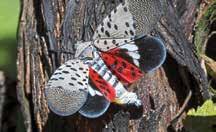
2 minute read
Biosecurity Mass trapping female fruit flies
Mass trapping female fruit flies in vineyards
Queensland fruit fly (Qfly) continues to be a problem in Sunraysia, with considerable implications for table grapes grown in this region.
In 2020, a new project kicked off that aims to develop a mass trapping strategy targeting female Qfly in and around table grape vineyards. The project is funded by Hort Innovation using the table grape research and development levy and contributions from the Australian Government.
Female Qfly are responsible for damaging produce by stinging fruits and laying eggs, which develop into hungry grubs. A mass trapping strategy, where traps are placed in and around the vineyard to catch these flies, could help manage Qfly as part of an integrated pest management (IPM) strategy.
The traps must contain a powerful attractant to lure the flies. The attraction of female Qfly to yeastbased protein baits has been well known for many years and is used in bait sprays and traps such as Biotrap, but research indicates that it is predominantly young, unmated, female flies that are attracted to protein, which the flies need to develop eggs. Mated females have a decreased attraction to these baits and may avoid capture by the traps, going on to lay their eggs in the crop.
Over the last few years, Agriculture Victoria has designed and field evaluated a trap that specifically targets mated female Qfly. The new trap mimics a juicy ripe fruit and combines a visual cue (a red sphere) with a specially designed synthetic fruit odour. In field trials the new trap captured significantly more mated female flies than commercially available traps in both stone and pome fruit orchards.
In the Hort Innovation project, Agriculture Victoria is looking at how this new trap, together with existing protein traps, might be incorporated into a mass trapping strategy specifically for table grapes.
“Vineyards are different environments to fruit orchards, so our first step has been to better understand how Qfly behave in and around the vineyard,” said Dr Paul Cunningham, who leads the project for Agriculture Victoria.
“Last season, we set out different types of traps to explore this, and learnt quite a lot about trapping in vineyards – such as the importance of perimeter trapping, and targeting ‘hot spots’ such as host trees growing close to the vines,” Dr Cunningham said.
The project is also conducting laboratory studies to examine whether different varieties of grapes are more susceptible to Qfly.
“This was something we heard from growers, so we wanted to test it in the lab,” said Dr Jessi Henneken, who is leading the experimental work on this project. “So far, our results suggest that different varieties of grape might indeed be more attractive to female Qfly, while other varieties better support larval development.”
The team intends to conduct more field trials in the 2021/2022 season and are keen to share their findings with the table grape industry and receive feedback that will help develop a mass trapping strategy that is well-suited for table grapes.
“We want to make sure that any mass trapping strategy we develop is practical for growers,” Dr Henneken said. “Does it complement the other management tools growers use? Will it be cost-effective? We are keen to hear from the people who will be using the management strategies.” v
Dr Jessi Henneken Agriculture Victoria











